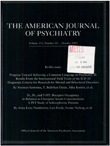The course of transient hypochondriasis
Abstract
OBJECTIVE: This study examined the longitudinal course of patients known to have had a previous episode of transient hypochondriasis. METHOD: Twenty-two transiently hypochondriacal patients and 24 nonhypochondriacal patients from the same general medical clinic were reexamined after an average of 22 months with the use of self-report questionnaires, structured diagnostic interviews, and medical record review. RESULTS: The hypochondriacal patients continued to manifest significantly more hypochondriacal symptoms, more somatization, and more psychopathological symptoms at follow-up. They also reported significantly more amplification of bodily sensations and more functional disability and utilized more medical care. These differences persisted after control for differences in medical morbidity and marital status. Only one hypochondriacal patient, however, had a DSM- III-R diagnosis of hypochondriasis at follow-up. Multivariate analyses revealed that the only significant predictors of hypochondriacal symptoms at follow-up were hypochondriacal symptoms and the tendency to amplify bodily sensations at the baseline evaluation. CONCLUSIONS: Hypochondriacal symptoms appear to have some temporal stability: patients who experienced hypochondriacal episodes at the beginning of the study were significantly more hypochondriacal 2 years later than comparison patients. They were not, however, any more likely to develop DSM-III-R-defined hypochondriasis. Thus, hypochondriacal symptoms may be distinct from the axis I disorder. The data are also compatible with the hypothesis that preexisting amplification of bodily sensations is an important predictor of subsequent hypochondriacal symptoms.
Access content
To read the fulltext, please use one of the options below to sign in or purchase access.- Personal login
- Institutional Login
- Sign in via OpenAthens
- Register for access
-
Please login/register if you wish to pair your device and check access availability.
Not a subscriber?
PsychiatryOnline subscription options offer access to the DSM-5 library, books, journals, CME, and patient resources. This all-in-one virtual library provides psychiatrists and mental health professionals with key resources for diagnosis, treatment, research, and professional development.
Need more help? PsychiatryOnline Customer Service may be reached by emailing [email protected] or by calling 800-368-5777 (in the U.S.) or 703-907-7322 (outside the U.S.).



